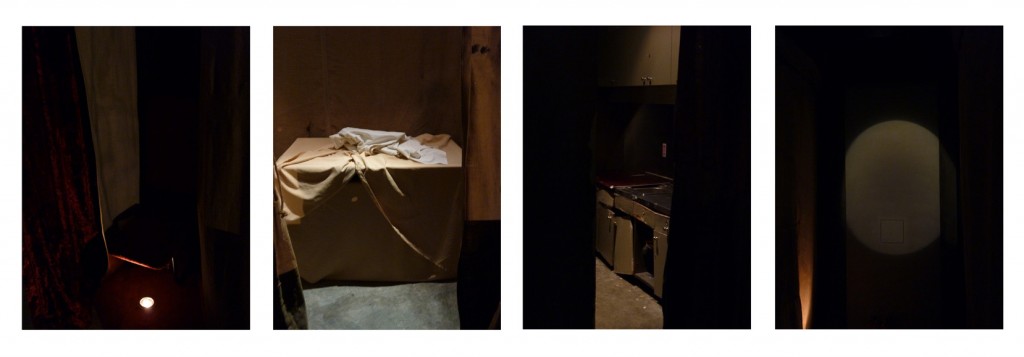‘I await the fragment that will concern me and establish meaning for me’[1]
I will give this image no contextual information, just the title ‘intermittance’.
Perhaps if I describe this image in some detail without identifying a time or place it can allude to different associations (through the reader), thus avoid becoming a document of cultural specifity. This may be the question behind the curtains; how do I read this context?
Without the markers of proportion, identity, or being, the image hovers beyond meaning, in the airy realm of “insignifiance”.[2]
Yet there are unavoidable cultural markers in this image. For one a small sign on the wall, but the language of typography is difficult to recognise, if not impossible due to distance and scale. The kitchen is signified as a standard ‘western’ configuration, but this signification can be represented across cultures. (A photograph looking down on a tombstone from above with barely legible typography in an unfamiliar language creates a similar disconnected allusion)
The view through the parted curtains—a dark red hue—into a half lit space revealing damaged cabinetry with stainless steel sink offers no clues to the circumstances of past events or actions. Why is this kitchen wrecked? Why photograph a destroyed kitchen through parted curtains?[3]
Two thirds of the image is obscured by the dark curtains, vertically, leaving a gap to which can be seen painted timber cupboard doors hanging off their bent hinges, partly open but not revealing their insides. Except for one cavity missing its door to reveal a solid round large object of indeterminate identification. The row of draws above the lower cupboards are also askew, slightly open due to the impossibility of closure, and along with the cupboard doors showing signs of surface abrasion and collision. The small area of concrete floor visible may have had its surface removed or simply worn back. It is also littered with small pieces of debris (paint scrapes?) possibly from the doors. The area above the lower cabinet where the small sign is located, is largely shrouded in darkness, except for the shine of the stainless steel sink, which displays similar impacts to the cupboard doors though less damaged due to its robust materiality. A row of cupboards sits on the wall above the kitchen benchtop, seemingly unaffected by the damage wrought beneath.
The semi-obscured tableux simmers with veiled revelations indexed to the body—eating/survival, violence/aftermath, concealment/desire; ‘the intermittence of skin flashing between two articles of clothing’.[4] The exposure revisits a past event now inhabited with a fictional displacement to which the reader may subject their own performance, their own text; ‘constructed or rhapsodised, or sewn together, from the fragments of woven fabrics or texts’.[5]
Intermittance, 2010
[1] Roland Barthes, A Lovers’s Discourse, 2002 ed. (London: Vintage Books, 1978).
[2] Beryl Schlossman, “The Descent of Orpheus: On Reading Barthes and Proust,” in Writing the Image after Roland Barthes, ed. Jean-Michel Rabaté(Philadelphia: University of Pennsylvania Press, 1997), 149. ‘Insignifiance’ is a further extrapolation on Kristeva’s term ‘signifiance’ as adopted by Barthes. ‘Signifiance refers to a meaning which must be produced by the reader’ (Allen, 84). I can only presume that Schlossman is extending this term to connote the further detachment of the signifer from the signified.
[3] See Jeff Wall’s The Destroyed Room in reference to Duchamp’s Etant donnés 1946-66
[4] Roland Barthes, The Pleasure of the Text, 1st American ed. (New York: Hill and Wang, 1975). p 10.
[5] Schlossman. p149.

